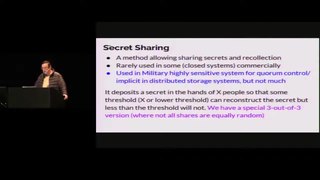In cryptography, a zero-knowledge proof or zero-knowledge protocol is a method by which one party can prove to another party that a given statement is true, while avoiding conveying to the verifier any information beyond the mere fact of the statement's truth. The intuition underlying zero-knowledge proofs is that it is trivial to prove the possession of certain information by simply revealing it; the challenge is to prove this possession without revealing the information, or any aspect of it whatsoever.
In cryptography, an oblivious transfer (OT) protocol is a type of protocol in which a sender transfers one of potentially many pieces of information to a receiver, but remains oblivious as to what piece has been transferred.
Secure multi-party computation is a subfield of cryptography with the goal of creating methods for parties to jointly compute a function over their inputs while keeping those inputs private. Unlike traditional cryptographic tasks, where cryptography assures security and integrity of communication or storage and the adversary is outside the system of participants, the cryptography in this model protects participants' privacy from each other.
Provable security refers to any type or level of computer security that can be proved. It is used in different ways by different fields.
In cryptography, a private information retrieval (PIR) protocol is a protocol that allows a user to retrieve an item from a server in possession of a database without revealing which item is retrieved. PIR is a weaker version of 1-out-of-n oblivious transfer, where it is also required that the user should not get information about other database items.
In cryptography, a password-authenticated key agreement (PAK) method is an interactive method for two or more parties to establish cryptographic keys based on one or more party's knowledge of a password.
The Diffie–Hellman problem (DHP) is a mathematical problem first proposed by Whitfield Diffie and Martin Hellman in the context of cryptography and serves as the theoretical basis of the Diffie–Hellman key exchange and its derivatives. The motivation for this problem is that many security systems use one-way functions: mathematical operations that are fast to compute, but hard to reverse. For example, they enable encrypting a message, but reversing the encryption is difficult. If solving the DHP were easy, these systems would be easily broken.
In cryptography, a pseudorandom function family, abbreviated PRF, is a collection of efficiently-computable functions which emulate a random oracle in the following way: no efficient algorithm can distinguish between a function chosen randomly from the PRF family and a random oracle. Pseudorandom functions are vital tools in the construction of cryptographic primitives, especially secure encryption schemes.
In cryptography, a secret sharing scheme is verifiable if auxiliary information is included that allows players to verify their shares as consistent. More formally, verifiable secret sharing ensures that even if the dealer is malicious there is a well-defined secret that the players can later reconstruct. The concept of verifiable secret sharing (VSS) was first introduced in 1985 by Benny Chor, Shafi Goldwasser, Silvio Micali and Baruch Awerbuch.
In computational complexity theory, a computational hardness assumption is the hypothesis that a particular problem cannot be solved efficiently. It is not known how to prove (unconditional) hardness for essentially any useful problem. Instead, computer scientists rely on reductions to formally relate the hardness of a new or complicated problem to a computational hardness assumption about a problem that is better-understood.
Non-interactive zero-knowledge proofs are cryptographic primitives, where information between a prover and a verifier can be authenticated by the prover, without revealing any of the specific information beyond the validity of the statement itself. This function of encryption makes direct communication between the prover and verifier unnecessary, effectively removing any intermediaries. The core trustless cryptography "proofing" involves a hash function generation of a random number, constrained within mathematical parameters determined by the prover and verifier.

Mordechai M. "Moti" Yung is a cryptographer and computer scientist known for his work on cryptovirology and kleptography.
In cryptography, server-based signatures are digital signatures in which a publicly available server participates in the signature creation process. This is in contrast to conventional digital signatures that are based on public-key cryptography and public-key infrastructure. With that, they assume that signers use their personal trusted computing bases for generating signatures without any communication with servers.
Matthew Keith "Matt" Franklin is an American cryptographer, and a professor of computer science at the University of California, Davis.

Yehuda Lindell is a professor in the Department of Computer Science at Bar-Ilan University where he conducts research on cryptography with a focus on the theory of secure computation and its application in practice. Lindell currently leads the cryptography team at Coinbase.

Amit Sahai is an Indian-American computer scientist. He is a professor of computer science at UCLA and the director of the Center for Encrypted Functionalities.
Garbled circuit is a cryptographic protocol that enables two-party secure computation in which two mistrusting parties can jointly evaluate a function over their private inputs without the presence of a trusted third party. In the garbled circuit protocol, the function has to be described as a Boolean circuit.
In cryptography, indistinguishability obfuscation is a type of software obfuscation with the defining property that obfuscating any two programs that compute the same mathematical function results in programs that cannot be distinguished from each other. Informally, such obfuscation hides the implementation of a program while still allowing users to run it. Formally, iO satisfies the property that obfuscations of two circuits of the same size which implement the same function are computationally indistinguishable.
Brent R. Waters is an American computer scientist, specializing in cryptography and computer security. He is currently a professor of Computer Science at the University of Texas at Austin.
An oblivious pseudorandom function (OPRF) is a cryptographic function, similar to a keyed-hash function, but with the distinction that in an OPRF two parties cooperate to securely compute a pseudorandom function (PRF).





